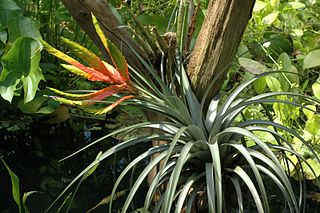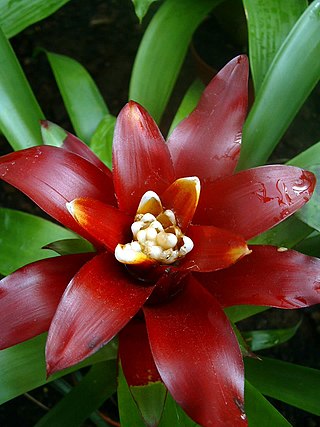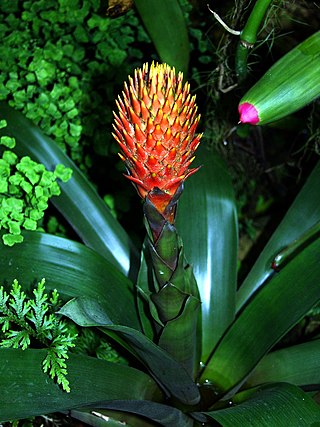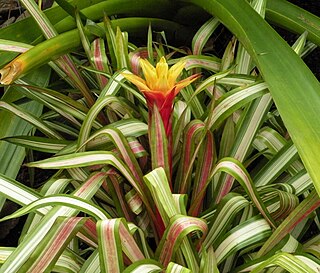
Guzmania is a genus of over 120 species of flowering plants in the botanical family Bromeliaceae, subfamily Tillandsioideae. They are mainly stemless, evergreen, epiphytic perennials native to Brazil, southern Mexico, Central America, and northern and western South America. They are found at altitudes of up to 3,500 m (11,483 ft) in the Andean rainforests.

Tillandsioideae is a subfamily of plants in the bromeliad family Bromeliaceae. This subfamily contains the greatest number of species. Most are epiphytic or lithophytic, growing in trees or on rocks where they absorb water and nutrients from the air. Spanish moss of the genus Tillandsia is a well-known species. Bromeliads in the genera Guzmania and Vriesea are the more commonly cultivated members of this subfamily.

Guzmania lingulata, the droophead tufted airplant or scarlet star, is a species of flowering plant in the family Bromeliaceae, subfamily Tillandsioideae. This evergreen epiphytic perennial is native to rainforest habitats in Central America, northern and central South America and southern Mexico. The Latin word lingulata means "tongue-shaped". The foliage grows in a star-shaped basal rosette culminating in an orange and red bracted inflorescence. It is among the most commonly cultivated bromeliad types, with cultivars producing flowers in shades of maroon, red, orange, yellow or pink.
Guzmania alcantareoides is a species of plant in the family Bromeliaceae. It is endemic to Ecuador. Its natural habitat is subtropical or tropical moist montane forests. It is threatened by habitat loss.
Guzmania andreettae is a species of plant in the family Bromeliaceae. It is endemic to Ecuador. Its natural habitat is subtropical or tropical moist montane forests.
Guzmania corniculata is a species of plant in the family Bromeliaceae. It is endemic to Ecuador. Its natural habitat is subtropical or tropical moist lowland forests. It is threatened by habitat loss.
Guzmania foetida is a species of plant in the family Bromeliaceae. It is endemic to Ecuador. Its natural habitat is subtropical or tropical moist montane forests. It is threatened by habitat loss.
Guzmania fosteriana is a species of plant in the family Bromeliaceae. It is endemic to Ecuador. Its natural habitats are subtropical or tropical moist lowland forests and subtropical or tropical moist montane forests. It is threatened by habitat loss.
Guzmania hirtzii is a species of plant in the family Bromeliaceae. It is endemic to Ecuador. Its natural habitat is subtropical or tropical moist montane forests. It is threatened by habitat loss.
Guzmania lepidota is a species of flowering plant in the family Bromeliaceae. It is endemic to Ecuador. Its natural habitat is subtropical or tropical moist montane forests. It is threatened by habitat loss.

Guzmania osyana is a species of plant in the family Bromeliaceae. It is endemic to Ecuador. Its natural habitats are subtropical or tropical moist lowland forests and subtropical or tropical moist montane forests. It was last known to be threatened by habitat loss in 2003.

Guzmania rubrolutea is an endangered species of plant in the family Bromeliaceae, endemic to Ecuador's subtropical or tropical moist montane forests, places of much habitat loss.

Guzmania monostachia is an epiphytic species in the genus Guzmania. Also known as a West Indian tufted airplant, this species is native to South America, Central America, the West Indies and Florida. The species is also reportedly naturalized in Hawaii.

Guzmania conifera is a species of flowering plant in the Bromeliaceae family. It is native to Ecuador and Peru.
Guzmania donnellsmithii is a plant species in the genus Guzmania. This species is native to Costa Rica, Panama, Nicaragua, and Ecuador.
Guzmania blassii is a plant species in the genus Guzmania. This species is native to Costa Rica.

Guzmania desautelsii is a species of Bromeliads in the genus Guzmania. A plant native to Costa Rica, Nicaragua and Panama, the species was originally described by Robert William Read and Lyman Bradford Smith in 1983.

Guzmania zahnii is a plant species in the genus Guzmania. This species is native to Panama, Nicaragua, and Costa Rica.

La Robleda Natural Protected Area is a 254-acre protected natural area and conservation easement in Cayey, Puerto Rico. La Robleda, meaning 'the oak grove', gets its name from the high concentration of pink manjack trees, locally known as roble blanco, in the area. The pink manjack trees in this nature reserve bloom for a few weeks every year, creating a natural scenic spectacle of pink and white colors in the Sierra de Cayey.










